Growing a fiddle-leaf fig (Ficus lyrata) can be one of the most rewarding achievements in indoor gardening.
With its large, lyre-shaped leaves and the potential to reach impressive heights, this houseplant is a staple in many homes – and many Instagram feeds.

We link to vendors to help you find relevant products. If you buy from one of our links, we may earn a commission.
f you want a full tutorial on growing and caring for this plant, read our guide. In this article, we’re going to focus on pruning these photogenic houseplants.
Here’s what we’ll cover:
Tips for Pruning Fiddle-Leaf Fig Trees
Fiddle-leaf figs can be finicky, and you might hesitate to trim them at all. What if it stresses them out? How do you prune them properly? We’ll cover all of this and more.
Let’s get started!
Why Should You Trim Your Fiddle-Leaf Fig?
As with many types of trees – and fiddle-leaf figs are technically trees! – trimming and pruning can help F. lyrata plants to stay healthy.
By removing dead or diseased leaves and branches, or trimming to promote better airflow between the foliage, you can keep this notoriously finicky houseplant happy.
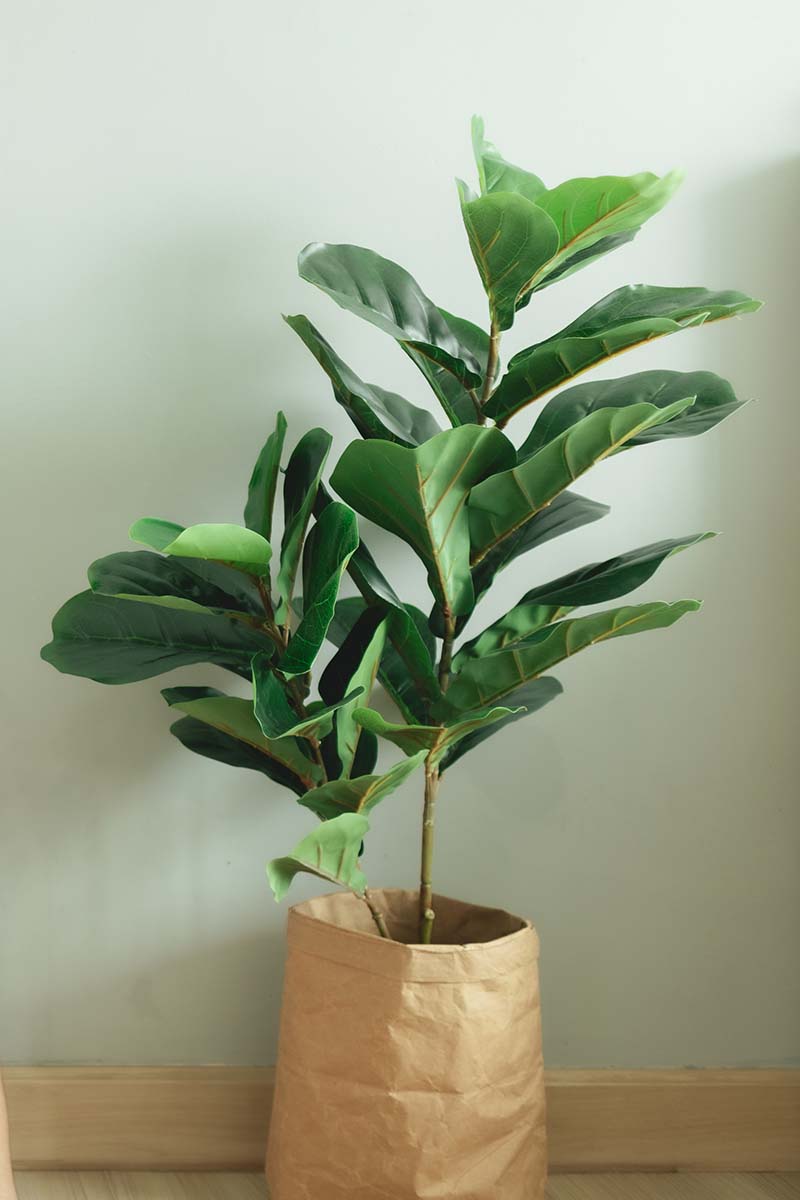
Or, at least it won’t be angry with you, your house, the entire world… Fiddle-leaf figs may have a quaint name, but I’d say they’re among the most opinionated plants around.
Pruning can also help you to keep your fig from outgrowing your home. F. lyrata can grow up to 12 feet tall under ideal indoor growing conditions. And in its native range – the lowland rainforests of western Africa – F. lyrata can grow up to 50 feet tall!
It won’t do this in your home, but it can grow up to two feet a year until it reaches its mature height. If you don’t want your ficus to overshadow, well, everything, pruning is a must.

You can also grow a dwarf variety if you don’t want to care for a giant tree inside your house. But there’s nothing quite as awe-inspiring as a tall, healthy F. lyrata contributing to the decor in a stylish home.
As long as it’s not pushing against your ceiling, that is.
Another thing to consider is shape. Fiddle-leaf figs are often sold as smallish, bushy or columnar houseplants with a single central stem, but many gardeners love cultivating theirs to create a tree-like shape.
We’ll dig into all that in a moment. First, let’s dive into the when and how of pruning your beloved F. lyrata.
When to Trim Your Tree
You can remove a diseased or dead leaf at any time. Trimming away these harbingers of sickness or infestation is better done sooner than later, in fact.
If you spot a leaf that looks yellow, brown, or diseased in some other way, trim it off with a clean, sharp pair of pruners.
But when it comes to pruning the actual branches, wait until growth resumes in the spring and summer. Even though you’re growing your F. lyrata indoors, it may go dormant or semi-dormant in the winter when there’s less light.
Pruning branches when the plant is enjoying its winter rest can stress it out, or even send it into shock. This can lead to sickness – or even the death of your cherished houseplant.
Since it’s not growing actively during dormancy, the cuts won’t heal as quickly as they would in the spring or summer, with the return of that bright, filtered light it loves so much.
These plants require at least six hours of bright daylight through a window, preferably one that faces south or east.
So, try not to get pruner-happy until springtime, and then you can give your plant a fresh trim for summer!
How to Prune
Before you get started, it’s a good idea to lay a few sheets of newspaper on the ground around your plant to protect the floors from fallen debris and the milky latex sap that will inevitably ooze out.
Make sure to keep the toxic latex away from your skin, and out of reach of children and animals. Wearing gloves and long sleeves is recommended.
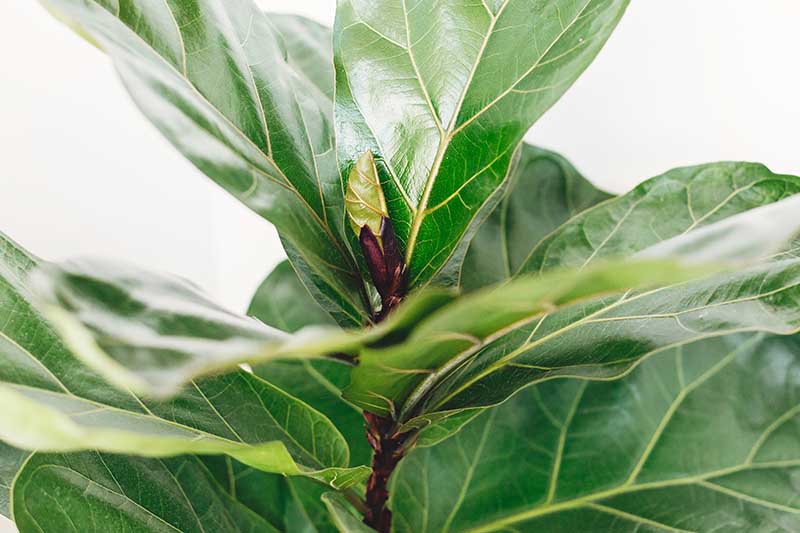
It’s also important to use a sharp, clean pair of pruners. If you aren’t sure if you cleaned them after the last time you used them, go ahead and clean them with soap and hot water. Dry them thoroughly before use.
If you’re pruning to shorten an overly tall plant you’ll be working with the central trunk or stem. Depending on the shape of your plant, this may be the only branch the tree has.
To make a cut, locate the area of the branch you want to trim. Then, lean in close and study the trunk. You’re looking for an internodal space, or a spot on the trunk that’s between two nodes.
Nodes are slightly raised rings in the bark of an F. lyrata tree that develop into leaves or branches.
Make a diagonal cut right in between the two nodes, and wipe the sap away with a damp rag. Within a few weeks, expect to see new lateral branches growing from the node just below your cut.
Sometimes, you’ll need to cut lateral branches.
F. lyrata is known for straining toward the light. You should be sure to rotate the planter every few days if you want to avoid having a lopsided plant, but alas, sometimes life happens and we forget to rotate our plants, and they end up leaning heavily to one side.

Or maybe you need to trim lateral branches off because the foliage is overcrowded.
By removing a branch or two, you can promote better airflow between those gorgeous, enormous leaves, which can help you to avoid issues with pests and disease.
Just take care not to prune more than 10 percent of the fiddle-leaf fig at any given time.
To prune lateral branches, make a cut just above the branch collar.
If you cut too close to the trunk, you risk wounding the tissue in the branch collar, and a wounded collar can allow disease pathogens to get into the trunk.
Cut too far away and the leftover branch may rot, potentially causing the branch collar to decay as well, which can also pave the way for infection.
If you simply need to prune a few dead or diseased leaves off of your plant here and there, just snip them off at the base with your pruners.
Shaping Your Fiddle-Leaf Fig
Earlier, I mentioned that F. lyrata tends to grow in a columnar or bushy shape when kept as a houseplant, and that many growers like to encourage a classic tree shape, complete with a clearly defined canopy and trunk.
F. lyrata does this on its own in the wild, dropping its lower leaves and developing into its natural form as a banyan tree.

Like the famous “regular” banyan, F. benghalensis, wild F. lyrata begins its life as an epiphyte. A seed lands in the canopy of another tree, germinates, and grows toward the earth, sometimes strangling its host plant in the process.
Obviously, your houseplant won’t do this, but the tree shape is aesthetically pleasing. How can you turn a bushy F. lyrata into a tall, graceful specimen?
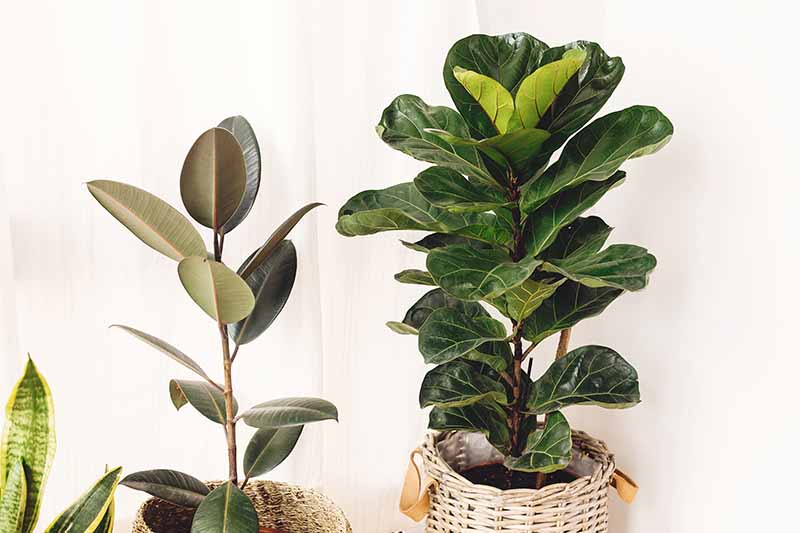
First off, if you’ve just purchased a coveted fiddle-leaf, don’t rush to start pruning it into a tree shape.
Let it grow to two-thirds of the desired height, whatever that means to you within the confines of your space. This allows the trunk to grow thick and strong.
If you want it to grow tall, keep in mind that it’s best to top the tree out at least eight to 10 inches away from the ceiling.
This not only looks better, but it also keeps the top leaves from bending and getting crushed against your ceiling.
So, for example, say you live in a home with nine-foot ceilings and want to top your tree out at about seven or eight feet. Based on these measurements, you won’t want to start pruning for lateral growth until the trunk is at least five feet tall.
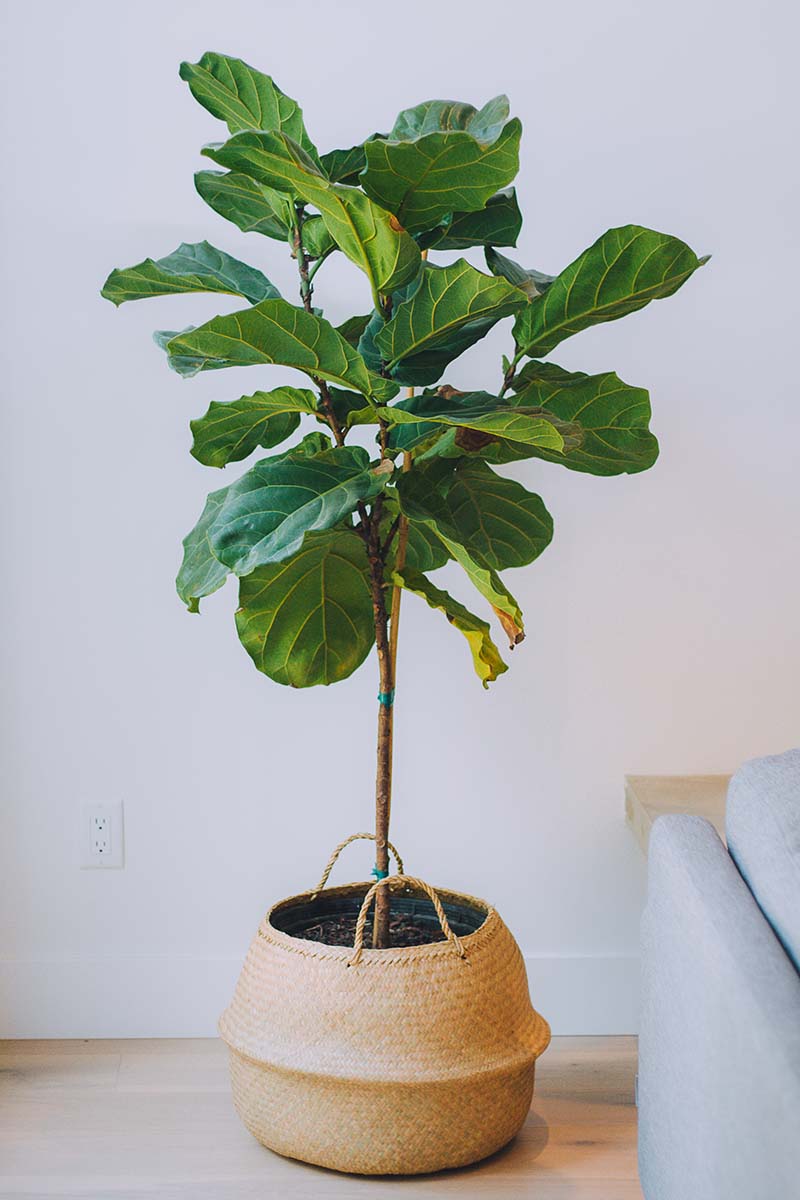
To prune your fiddle-leaf fig to create a tree form with branching lateral growth, wait until spring or summer – when the plant is actively growing – and make a cut at least six inches down from the tip of the tree.
You can save this cutting and propagate it! Make sure to cut in an internodal space.
Resist trimming off the leaves below the cut. You want them to stay so that the plant can photosynthesize to produce energy so that it can grow those lateral branches.
Your F. lyrata will begin to branch from the cut within a few weeks. Sometimes you’ll get one branch, but it’s not uncommon for this tree to sprout two or three new lateral branches.
Once the new branches develop leaves, you can prune away one or two leaves from the base area of the tree.
As the canopy matures, the leaves and new branches will deepen in color. When you notice this, feel free to prune another leaf or two off of the lower portion of the trunk.
Over time, as the canopy continues to develop, you can keep pruning leaves off the trunk portion of the tree. Eventually, you’ll develop a nice, clean trunk supporting a Y-shaped canopy.
Note: some advanced gardeners like to use a procedure known as “notching” to produce lateral branches. With this method, the gardener makes a careful incision right between two nodes. The idea is that this cut will prompt the tree to grow lateral branches without sacrificing height.
Sometimes notching works, and sometimes it doesn’t.
F. lyrata grows quickly and we know that pruning for lateral branch growth provides consistent results, which is why it’s our recommended method for creating that lovely canopy.
After pruning, make sure you keep giving your plant stellar care – appropriate water, fertilizer, and light – which will help it to heal more quickly from its wounds.
Fiddly Fun
It can be slightly terrifying to cut into your fussy fiddle-leaf fig, but the results are worth it.
As long as you wait until the right time of the year, use a clean pair of pruners, and give your plant the care it needs all year long, both you and your plant will be alright.
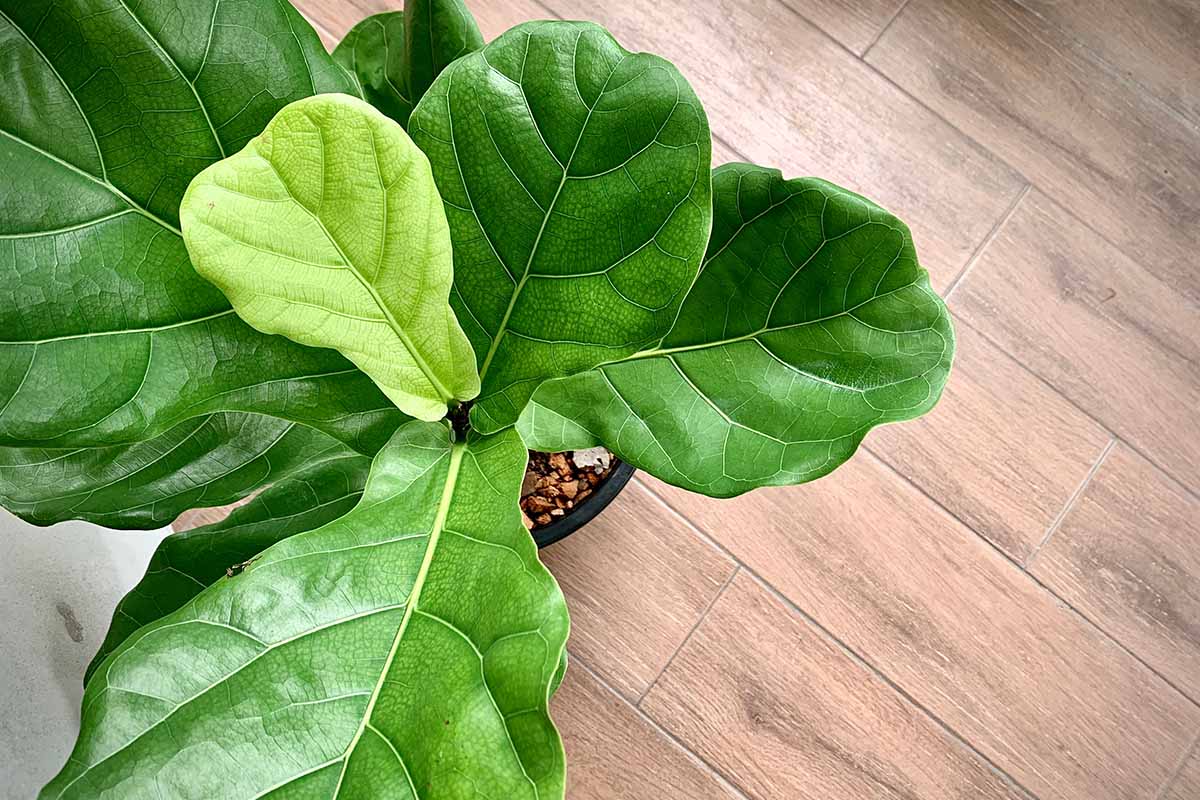
Have you ever tried pruning your fiddle-leaf fig? Share your stories and questions in the comments below! We love to hear from you.
And for more information about growing houseplants, check out these guides next:
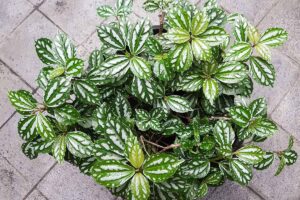


Hello Laura, We have a pair of fiddle figs that are growing from the same planter. They are about 9-10 ft tall and the roots are conjoined. We’d like to separate and trim down. What’s the best method to separate the roots?
You can separate them by doing some gradual root pruning. First, remove the plant and cut 1/4 of the roots from the bottom of the conjoined root ball. Re-pot, water thoroughly, and wait a couple weeks. If the tree(s) appear to be taking the pruning fine, you can remove the plant again and use a root pick to carefully tease the two trees apart. Repot with fresh soil — see our main growing guide for more details.
Hi Laura,
How long of a rest should I give the tree between prunings?
It’s ideal to prune just once a year if you can get away with that, but otherwise leave at least a few months in between pruning to give your fig the chance to recover.
Hi Laura, my Fiddle fig has three new lateral branches growing right now at the very top. There are about six little baby leaves sprouting, but my plant is inches from the ceiling, about 8 feet. Can I prune off the top third or so of the plant and try to propagate it while it has these baby leaves? And thus also encouraging the remainder of the plant to take more of a tree shape?
Yes and yes! I apologize for the late reply — just saw this, and you can definitely do that if you haven’t already.
Hi, can you advise what to do with my very tall Fiddle Fig, I would like to trim it down a bit but don’t want to kill it – can I cut it down so it branches out? also, do the cutting propagate well?
Hi Patricia! You can absolutely trim it down. Follow the “How to Prune” section of this guide for tips on pruning. And the cuttings do propagate! Check out the propagation section of our main guide to growing fiddle-leaf figs for detailed propagation information.
Incredible info – thanks so much! The most thorough post on pruning fiddles I’ve found online!
Can you propogate the cutting by simply placing it in water? Or is more delicate than that?
Hi Sam, you can absolutely propagate the cuttings by placing them in water, but I recommend using a potting medium if you can. The problem with rooting in water is that the roots that form aren’t ideal for soil, so the plant has to re-adjust once you move it from water to soil. Still, don’t let that stop you, just know that it can be more of a challenge. If you do decide to propagate in a potting medium, use something light and airy like an equal mix of orchid bark, rice hulls, and potting mix with a handful of… Read more »
I understand you don’t want to start branching a fiddle until it’s about 5 feet tall. I have a bambino that has grown so tall, but I’m not sure where to cut off the top because I don’t know how tall this variety grows.
Any help would be appreciated.
That’s actually tall for a bambino – they usually stay around three feet tall. Feel free to snip off that top and start branching anytime you want. It won’t hurt the tree and the five-foot marker is just a suggestion. You can branch them when they’re shorter if you want.
I received four fiddle-leaf fig plants in one pot. They were a gift. Three were already 5′ high, the fourth, barely 2′ high. In 2 summer months, two of the plants topped 6′. Thanks for the info on pruning them. None of them had ever been pruned – no branches. The plants are extremely happy and healthy in a south window. This plant is new to me and, so far, I’ve had success. Questions: should I leave all four plants in the same pot? If they should be separated, when is the ideal time to separate and repot? Will I… Read more »
Sounds like you received quite the beautiful gift! Your plants will start to become crowded pretty quickly, so I’d suggest separating them. Do this in the late fall, winter, or early spring when the plant is in its dormant state. You can prune them back as short as you want. If you cut the main stem, new branches will form at the bud below where you cut. If you’d like them to be about four feet, cut the main stem at about three feet and let the branches grow up from there.
When I cut off the top of my plant to repot do it trim off the leaves or just plant the whole piece of trim off?
Hi Nancy, you should cut off all but two leaves from the cutting that you take and you want to ensure that you have one node exposed. We have a section in our main growing guide on fiddle leaf figs that goes into this in more detail. Check out the section on propagation at home.
Hi – I have a tall fiddle leaf with 2 branches – one more straight up and one really off to the side so that the tree looks like a lop-sided Y. The one to the side is really heavy and I would like to cut it off or back bc I think it is impacting the rest of the plant. It is probably a 3 foot long branch – how much can I take off at one time? Thanks!!!
Hi Mary, so long as you don’t cut off more than a third of the leaves at one time, your plant should be fine. So if you cut the branch off or by half and there are still two-thirds of the original leaves left, the plant should recover with no problem. A bit of a hard prune now and then can actually help the plant in the long run, so don’t be afraid to go for it.
Thanks for the excellent and comprehensive article. I am off to trim now 🙂
PS I am in the New Zealand, in the southern hemisphere, so it is nearly summer here
Awesome, glad this guide helped, and have fun! I’ll try my best not to be too jealous about your summer weather while I’m bundled up in my winter sweaters.